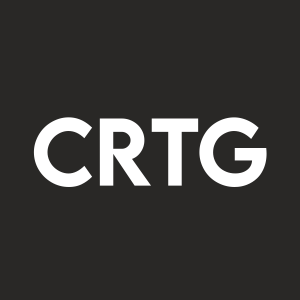The Coretec Group & University of Adelaide’s Research Work on CSpace Technology Selected for Presentation at SPIE Photonics West Conference
The presentation will detail the latest promising research discoveries in Coretec’s CSpace 3D display technology
ANN ARBOR, Mich., Nov. 21, 2023 (GLOBE NEWSWIRE) -- The Coretec Group (OTCQB: CRTG), developers of silicon anode active materials for lithium-ion batteries, and cyclohexasilane (CHS) for EV, cleantech, and 3D display technology, today announced that its research in partnership with The University of Adelaide on its CSpace 3D volumetric display technology has been selected for presentation at the 2024 SPIE Photonics West Conference. Taking place in San Francisco, CA, on January 30, 2024 at 4:40 pm PST, the presentation details the most recent CSpace research developments. It will be given by Adelaide’s Dr. Yunle Wei.
The presentation is based on Coretec’s CSpace technology that utilizes two invisible infrared lasers to generate visible, 3D image pixels in glass within an imaging chamber. The research evaluated three types of alternative low-phonon-energy types of glass that possess high optical quality and the potential for mass manufacturing. Tellurite glass was found to be the most promising candidate, due to its high fluorescence efficiency for display and up-scalability of the imaging chamber size. The technology can be used in a wide array of applications including medical imaging, automotive and aerospace design, visualization in weather, defense monitoring, and many others.
“Our work with The Coretec Group has been highly beneficial and generated encouraging results,” said Dr. Wei, Post Doctoral Researcher at the University of Adelaide’s Institute for Photonics and Advanced Sensing (IPAS). “I look forward to connecting with and presenting our exciting results to fellow industry professionals.”
“We’re encouraged by the results from The University of Adelaide, and excited to share them with leaders in the photonics industry,” said Matt Kappers, CEO of The Coretec Group. “While our Company’s efforts continue to focus on Endurion, we are eager to pursue new milestones in the development of our CSpace technology, and aim to ultimately realize the shareholder value of this highly specialized product.”
About The Coretec Group
The Coretec Group, Inc. is an Ann Arbor, Michigan-based developer of engineered silicon and is using its expertise to develop silicon anodes for lithium-ion batteries that will charge faster and last longer. This program is called Endurion. Silicon has the theoretical ability to hold up to 10x the amount of lithium-ions as compared to traditional graphite. Through its proprietary nanoparticle approach, Endurion is loading silicon into the battery anode. A modest increase in silicon will be a game changer that will revolutionize the EV market as well as other energy storage applications.
Additionally, the Company is using its engineered silicon to develop a portfolio of other energy-focused products, including solid-state lighting (LEDs), semiconductors, and printable electronics. Coretec continues to develop CSpace, its 3D volumetric display technology with a wide array of applications including medical imaging, automotive, and others.
For more information, please visit thecoretecgroup.com.
Follow The Coretec Group on:
Twitter – @CoretecGroupInc
LinkedIn – www.linkedin.com/company/24789881
YouTube – www.youtube.com/channel/UC1IA9C6PoPd1G4M7B9QiZPQ/featured
Forward-Looking Statements
The statements in this press release that relate to The Coretec Group’s expectations with regard to the future impact on the Company’s results from operations are forward-looking statements and may involve risks and uncertainties, some of which are beyond our control. Such risks and uncertainties are described in greater detail in our filings with the U.S. Securities and Exchange Commission. Since the information in this press release may contain statements that involve risk and uncertainties and are subject to change at any time, the Company’s actual results may differ materially from expected results. We make no commitment to disclose any subsequent revisions to forward-looking statements. This release does not constitute an offer to sell or a solicitation of offers to buy any securities of any entity.
Corporate Contact:
The Coretec Group, Inc.
Lindsay McCarthy
info@thecoretecgroup.com
+1 (866) 916-0833
Media Contact:
Spencer Herrmann
FischTank PR
coretec@fischtankpr.com
+1 (518) 669-6818








